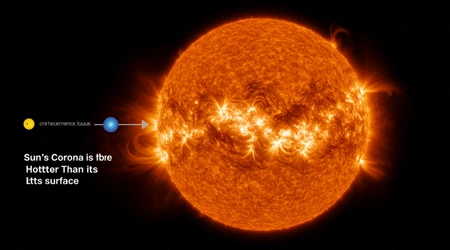Why the Sun’s Corona Is Hotter Than Its Surface (And Why That’s Weird)

Imagine staring at our nearest star, where the sun’s corona is hotter than its surface, defying every instinct about heat and distance.
Anúncios
This enigma has puzzled astronomers for decades, flipping expectations upside down. You’d think the blazing core would make everything cooler as you move outward, right? Yet, the corona blazes at millions of degrees while the surface simmers below.
Scientists chase this riddle because it unlocks solar wind secrets and space weather forecasts. Recent missions like Parker Solar Probe dive close, revealing fresh clues. Why does this matter to you? Solar flares from that hot corona can zap satellites or dazzle with auroras.
Picture a campfire: flames lick close and hot, but embers fade farther out. The Sun reverses that its outer halo roars hotter. This analogy highlights the weirdness, urging us to question basic physics assumptions.
In 2025, data flows from probes skimming the Sun, painting a dynamic picture. We explore waves, magnetic snaps, and tiny bursts driving this heat. Buckle up as we dissect this cosmic oddity step by step.
The Puzzling Temperature Inversion
Astronomers first spotted this in the 1930s during eclipses. The photosphere glows at about 5,500°C, but the corona spikes to over a million. That’s the core puzzle: heat flowing against gradients.
Thermodynamics screams no heat should dissipate outward. Yet, energy pumps into the thin corona, making it sizzle. Probes now measure this directly, confirming the inversion.
Why weird? It’s like your oven door scorching hotter than inside. This defies conduction laws in everyday experience. Solar physicists argue magnetic fields twist the rules here.
++ How the Sun’s Magnetic Field Shapes the Entire Solar System
Observations show the transition zone bridges these layers sharply. Temperatures jump wildly in mere kilometers. Spacecraft data pinpoints where the flip happens.
Eclipses reveal the corona’s pearly glow, hinting at its heat through spectral lines. Iron ions stripped bare signal extreme conditions. This visual clue sparked the hunt.

Leading Theories Behind Coronal Heating
One idea: Alfvén waves ripple through plasma, dumping energy as heat. These magnetic oscillations carry power from below, crashing in the corona.
Recent models show kinetic Alfvén waves accelerate particles directly. They interact with ions, boosting temperatures selectively. Simulations back this wave-particle dance.
Magnetic reconnection snaps field lines, releasing bursts like mini-flares. These reconnections happen constantly, injecting heat sporadically across the corona.
Nanoflares, tiny explosions, pepper the atmosphere. Though small, their sheer number adds up. Observatories spot these fleeting events now.
Also read: Solar Tornadoes: What They Are and Why They Matter
Debate rages: waves or reconnections dominate? Hybrid models blend both, arguing they interplay. Evidence tilts toward waves in open fields, reconnections in loops.
Critics say waves dampen too slowly. But 2025 studies refine damping rates, showing efficiency in turbulent plasma. This shifts the argument.
Reconnection fans point to loop brightenings as proof. High-res images capture these snaps, linking them to heating spikes. The evidence builds.
Recent Breakthroughs from Space Missions
NASA’s Parker Solar Probe zipped to 3.8 million miles in 2025, spotting the helicity barrier. This blocks energy flow, trapping heat in the corona.
The barrier explains why waves reflect and amplify. Data shows twisted magnetic helicity creates this wall, solving part of the puzzle.
ESA’s Solar Orbiter snapped wide corona views in April 2025. Images reveal plasma wisps like raindrops, hinting at steady heating mechanisms.
Orbiter’s south pole observations in June caught polar winds. These tie heating to fast solar streams, impacting Earth’s magnetosphere.
Read more: The Parker Solar Probe: Flying Into the Heart of Our Star
Parker ruled out switchbacks as heaters last year. No S-bends in fields near the Sun, narrowing suspects.
Adaptive optics from ground telescopes in May showed fine structures. These “raindrops” suggest nanoflare clusters, visible in stunning detail. Missions collaborate: Parker dives deep, Orbiter scans wide. Together, they map heating variations across latitudes.
Implications for Solar Science and Beyond
Understanding this drives better space weather predictions. Hot corona fuels solar wind, which triggers geomagnetic storms on Earth.
Engineers design hardier satellites knowing flare risks. Telecoms brace for disruptions from coronal mass ejections.
Broader: this probes plasma physics extremes. Labs mimic conditions, testing fusion reactors for clean energy. What if we harness similar heating? Rhetorical, but it sparks innovation in materials under heat.
Example one: think of a guitar string vibrating waves build until snapping hot. Original twist on Alfvén waves in corona.
Second example: popcorn kernels popping unevenly, like nanoflares heating patches. Uneven bursts mirror observed loops. Statistic: the corona reaches 200 times the surface temperature in spots, per mission data.
Analogy: like a microwave heating food from inside out, defying surface expectations. Future missions aim closer, chasing full answers. By 2030, we might crack it entirely.
This weirdness reminds us: nature hides surprises. Digging deeper enriches our cosmic view. Stay tuned for more solar revelations.
In wrapping up, the sun’s corona is hotter than its surface challenges our grasp of stars. Missions peel layers, revealing magnetic mayhem at play.
Yet questions linger. Will waves or reconnections win? 2025 breakthroughs tilt toward barriers and reflections, but debates simmer.
Ponder this: our Sun, a plasma lab in the sky, teaches resilience against cosmic forces. Embrace the weird it fuels discovery.
Below, a table of Sun’s atmospheric layers and temperatures:
| Layer | Temperature (°C) | Key Feature |
|---|---|---|
| Photosphere | ~5,500 | Visible surface, granulation |
| Chromosphere | 4,000-20,000 | Spicules, transition zone |
| Corona | 1-3 million | Solar wind origin, flares |
This table highlights the stark jump, underscoring the weirdness.
The sun’s corona is hotter than its surface isn’t just trivia it reshapes astrophysics. Probes in 2025 bring us closer to truths.
Debunk myths: no, it’s not fusion leaking out. Magnetic dynamics rule.
Finally, the sun’s corona is hotter than its surface invites wonder. What other stellar secrets await? Dive into solar science today.
Frequently Asked Questions
What causes the sun’s corona is hotter than its surface?
Leading ideas include magnetic waves and reconnections transferring energy outward. Recent probes like Parker confirm barriers trap heat.
How hot is the corona compared to the surface?
Surface hits 5,500°C; corona soars to 1-3 million°C. That’s the inversion puzzle.
Why does this matter for Earth?
Hot corona drives solar wind and flares, affecting power grids and communications. Better understanding aids forecasts.
What’s the helicity barrier?
Discovered in 2025, it’s a magnetic twist blocking energy escape, explaining trapped heat in corona.
Are there other stars with similar issues?
Yes, many show hot outer atmospheres. Our Sun helps model them.
